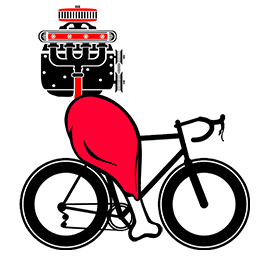Jump Straight to the Gearing Results
Perhaps there is nothing more misunderstood in the Zwift world than trainer difficulty.
Some people have (wrongly) postulated that if they are racing with the Difficulty slider at 100% against someone racing at 50%, they are at a disadvantage. This is not mathematically true. In Zwift, watts are watts. The difference is the feedback in terms of resistance your legs get on an incline (and decline).
On Zwift, keep in mind you have a virtual rider who is propelled by watts. You also have the real world you in which you create those watts.
There are two ways to generate more watts. (1)Press harder on the pedals (force/torque) or (2) spin the pedals faster.
Zwift Difficulty is said to be a decrease in the gradient of a hill in terms of what is presented to your legs in terms of resistance on the trainer.
- At 100% Difficulty on a 10% gradient, you feel the full 10% in terms of pedal resistance.
- At 75% on a 10% gradient, you are only experiencing a 7.5% gradient in terms of pedal resistance.
- At 50% Difficulty, that hill is now a 5% gradient in terms of pedal resistance.
And so on…
Here are how things even out. Your on-screen-rider is STILL going up a 10% gradient and needs that amount of virtual watts to get up the climb even though your Trainer Difficulty can make the gradient feel reduced to you the real-rider.
So if you are racing someone and they are at 100% difficulty, and you are at 50%, their trainer resistance will be higher, and they will be putting out more force and watts than you at the same cadence as you. To keep up with the 100% rider in the same IRL (in real life) gear as you, you will need a much higher cadence to output the watts needed to drive your virtual rider up the climb.
So a good comparison/analogy is to see trainer Difficulty as your available gear selections. But realize that your available gear selection changes based on the gradient of the hill.
At 100% difficulty, you are locked into your real-world gearing on your bike. So if you are riding a steep climb in your granny gear of 34×28 is too difficult to spin at 80 RPM cadence, all you can do is reduce your cadence. Just like IRL, you’ll be slogging up that hill at some incredibly low RPMs (aka the dreaded 50 RPM climb). This is usually not the most advantageous physiological means to get a bike up a hill. There is a lot of taxing on the muscular system at 50 RPMs cadence.
But, with the Difficulty reduced to 75%, you now have a bigger granny gear at your disposal, and at 50% an even bigger one. You can now spin at higher cadences than you could on your real-world gears. (But don’t forget, you’ll have to spin faster to go the same speed online).
But Just How Much Bigger Are the Gears at Each Percentage?
Ahhhh, time for an experiment and a report.
Test method:
- Climb up a specific segment of Alpe du Zwift that is a 10% gradient at the same cadence but with different difficulty settings. In this experiment, cadence is the constant in the equation. I chose 80 RPMs because it seems like a good balance between grinders and spinners. I chose the 10% segment because that is a solid round number.
- Trainer Difficulty is the variable. The test was performed at 100%, 75%, 50%, and 25% difficulties.
- Speed will be the outcome. Spinning at 80 RPMs at 100% difficulty makes your virtual rider go faster than spinning at 80 RPMs on 75% difficulty. So the speed in mph is the important piece of the experiment.
- Once we get the speed for each difficulty level, we can reverse engineer the speed at cadence to approximate the gear using Sheldon Brown’s Online Gear Calculator.
Note: I ran this test twice at each Difficulty, but it needs more repetitions to be definitive. Also, the gradient does affect the results. A lesser gradient would be a smaller equivalent gear difference. But 10% is a pretty classic climbing percentage, and Alpe du Zwift is the most iconic climb (granted the overall ADZ climb averages 8.5% overall). When I have time, I’ll rerun this on this segment and at other gradients.
Set up data for the experiment.
- 77 kg rider on Zwift.
- Sheldon Calculator inputs using 700ccx25 tire and 172.5mm cranks. Yes, I am using a direct drive trainer IRL, but I had to pick something for that value.
Runs at 100% Difficulty and 80 RPM Cadence on 34×28 (2 run average)
Speed achieved in Zwift 7.98 mph
Runs at 75% Difficulty and 80 RPM Cadence on 34×28 (2 run average)
Speed achieved in Zwift 6.54 mph
Runs at 50% Difficulty and 80 RPM Cadence on 34×28 (2 run averages)
Speed achieved in Zwift 4.65 mph
Runs at 25% Difficulty and 80 RPM Cadence on 34×28 (2 run averages)
Speed achieved in Zwift 2.69 mph
Then we reverse-engineered the equivalent gears on Sheldon’s calculator.
The Results
| Difficulty Setting | Gear Equivalent on 10% Climb | Watts Required for 80 Cadence |
| 100% | 34 x 28 (real-life test gear) | 311 watts |
| 75% | 34 x 33 | 248 watts |
| 50% | 34 x 46 | 177 watts |
| 25% | 34 x 77 (aka the whopper) | 93 watts |
Summary and Insights
You can get some whopping big granny gears in Zwift using the Difficulty setting. For riding inside the Zwift world, you can virtually swap out your cassette just by reducing the percentage. Spin like Froome or grind like Ulrich, whichever you prefer to go fast.
On a 10% climb, reducing the difficulty to 25% means that you have a massive gear available to you. Granted, you will need to spin the snot out of it, because at 80 RPM and 2.69 mph it will take you 2 hours and 47 minutes to arrive at the summit. Of course, you can always run at 25% difficulty and simply use a bigger real-world gear. Heck, run your big ring and feel like a pro.
When racing, you can reduce Trainer Difficulty, just realize on every incline you’ll have to spin faster than your competitors due to the decrease in gradient effect. As you see in the chart above, you are at 25% difficulty and your opponent 100% spinning at the same cadence, you’ll get dropped like a hot rock.
One caveat, if you are going to do some massive real-world climbs, you might not want to not dial down the difficulty on Zwift. Instead, get used to grinding your real-world gear limitations once you run out of gears.

Jordan Fowler has experience as a head swimming coach of the Frisco Swim Team, a TAAF-awarded coach, a track and field distance running consultant for select Texas High School runners, and has competed as a triathlete, road runner, and cyclist. Though he is remarkably slower than he was in his 20s and 30s, he still enjoys endurance sports and sports science studies.


Really excellent experience and write up. Great job.
What about the other gears? Will they be evenly distributed or will there be som kind of increase in the difference as you go toward your granniest gear? And will your lowest gear be affected at all?
All gears will be affected by the gradient, as the gradient is being reduced by 75% or 50% or 25% no matter what gear you are in; so your 11 or 12 cog in the rear won’t be an 11 or 12 on that on a climb anymore, it will be larger. Note, it will still be 11 or 12 on a flat, no matter what the Trainer Difficulty is set on.
Couldn’t have simplified that explanation any easier. Well done for us n00bs!
Hi Jordan, I left a comment before but I cannot see it listed so I am leaving another. Would it be possible to get in touch by email about this post?
Thanks a lot!
Really appreciate you sharing your experiment and insight on the impact of Zwift trainer difficulty on the simulation of gearing. From a pure gear ratio analysis on https://zwiftinsider.com/trainer-difficulty-gear-ratio/, it suggested that for a 34/28 to simulate a 34/34 would require a difficulty setting of 82%. I am assuming that your finding of what would be closer to 70% for 34/34 likely takes into account your weight and any cadence variation at the 10% grade, correct? Nice that I am a similar weight, and also run a 50/34 11-28!
I will give Alpe du Zwift a try in that 70%-80% range to see what it is like on my 34/28. For summer IRL rides in the mountains, might need to splurge on going to a GS cage Di rear derailleur to run an 11-34 cassette, as trying to spin 11-28 up big grades over a long ride is too much!